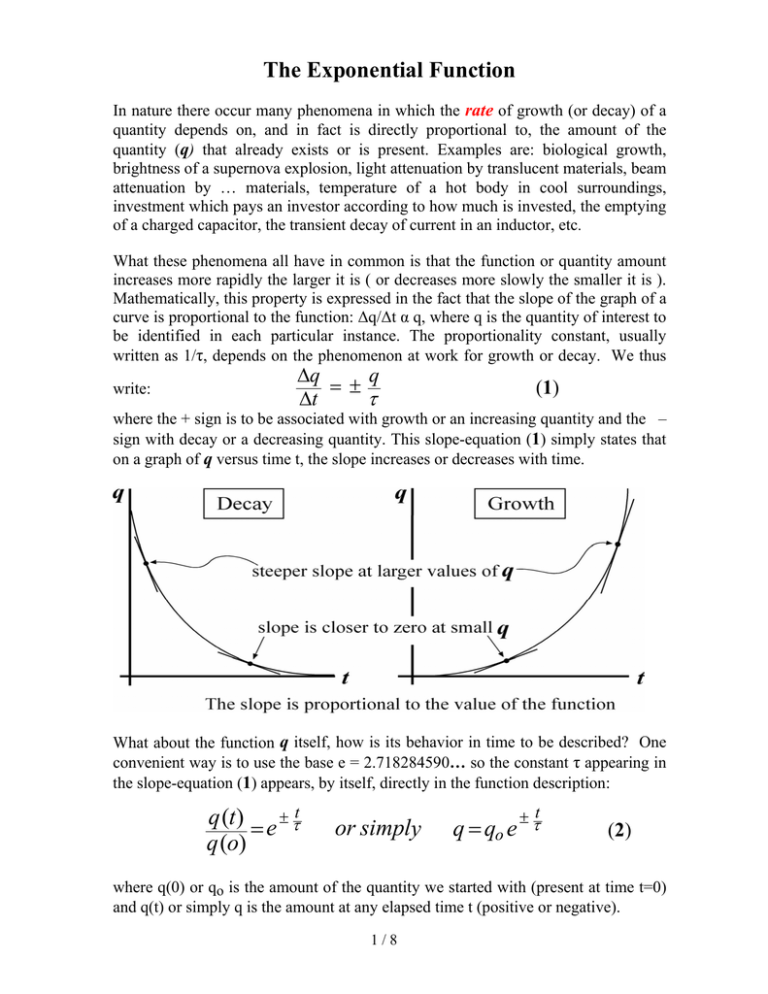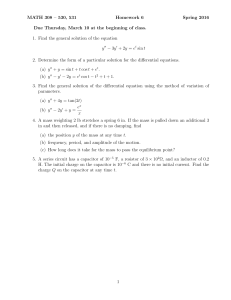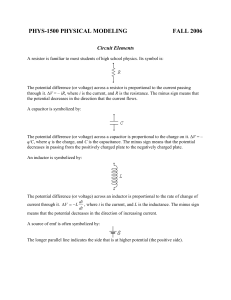Exponential Function
advertisement

The Exponential Function In nature there occur many phenomena in which the rate of growth (or decay) of a quantity depends on, and in fact is directly proportional to, the amount of the quantity (q) that already exists or is present. Examples are: biological growth, brightness of a supernova explosion, light attenuation by translucent materials, beam attenuation by … materials, temperature of a hot body in cool surroundings, investment which pays an investor according to how much is invested, the emptying of a charged capacitor, the transient decay of current in an inductor, etc. What these phenomena all have in common is that the function or quantity amount increases more rapidly the larger it is ( or decreases more slowly the smaller it is ). Mathematically, this property is expressed in the fact that the slope of the graph of a curve is proportional to the function: ∆q/∆t α q, where q is the quantity of interest to be identified in each particular instance. The proportionality constant, usually written as 1/τ, depends on the phenomenon at work for growth or decay. We thus write: ∆q q =± ∆t τ (1) where the + sign is to be associated with growth or an increasing quantity and the – sign with decay or a decreasing quantity. This slope-equation (1) simply states that on a graph of q versus time t, the slope increases or decreases with time. What about the function q itself, how is its behavior in time to be described? One convenient way is to use the base e = 2.718284590… so the constant τ appearing in the slope-equation (1) appears, by itself, directly in the function description: q (t ) = e ± τt q (o) or simply q = qo e ± τt (2) where q(0) or qo is the amount of the quantity we started with (present at time t=0) and q(t) or simply q is the amount at any elapsed time t (positive or negative). 1/8 The base e is used because in many situations the rate of change of the function (the slope) is known in terms of the constant τ, but the function itself is not known. Thus whenever equation (1) is obeyed by some phenomenon, it is then a simple matter to describe the function itself immediately with the same single constant τ in equation (2) provided we use the natural base e. In short, equation (1) implies equation (2) and vice versa due to the definition of the natural base e. What about τ which is commonly referred to as the growth, decay, time, or relaxation constant. We have stated that its value will depend on the phenomenon or mechanism responsible for the growth or decay. More importantly, it describes this phenomenon or mechanism using a single constant value which can readily be obtained from a graph of measurements i.e. from the slope-equation (1). This constant τ is most easily regarded as a special unit if we agree to measure abscissa values in terms of so many τ’s. To illustrate, suppose we have a system whose mechanism for growth (or decay) has a time constant of say 13 days. Now, if a total time of t = 39 days has elapsed since the amount of the quantity was qo at time t = 0, then the fraction present after these three time constants ( t = 3τ ) is: using equation (2): 39 days e+3 = 20 times when increasing ± q(t = 39) 13 days =e = −3 q(t = 0) e = 0.05 or 5% when decreasing ±0 Note: at the start time t = 0, the fraction q/qo = e = 1 or 100 % as expected. ∞ for growth (+) q(t =∞) = e ±∞ = After a long time q(t = 0) 0 for decay (−) It is worthwhile remembering the following six practical points: 1. If a system behaves according to equation (1) or is described by exponential growth or decay equation (2), then the strength of that system’s phenomenon can be described by a single constant τ. 2. In order to obtain the value of the constant τ off a graph of q versus time t, note that the fraction q/qo is exactly either half (½ , 50 %) or double (2) at the time t/τ = ℓn 2 = 0.6931. 3. If the exponential function continued to decay at its initial rate, the duration of the function would be just equal to the constant τ. 4. In any abscissa (time) interval equal to the constant τ, the quantity q decays to a fraction 1/e = 0.37 or 37 % of its value at the beginning of the interval. This abscissa value is commonly referred to as the relaxation interval. 5. As a practical rule of thumb one speaks of whatever is occurring as being over and done with in five (5) time constants because at t = 5τ : decreasing: e–5 = 0.007 less than 1 % remains increasing: 1 – e–5 = 0.993 more than 99 % has been gained. 6. The area under the curve during any doubling (or halving) is equal to the area under the entire preceding (following) curve. Can you prove it? 2/8 Application: Spontaneous Decay The energy of any bound system is restricted to certain discrete values which are called the energy levels of the system. The lowest possible energy level of the system corresponds to the ground state which is stable, meaning an isolated system will remain in that state indefinitely. When a system finds itself with an energy level above its ground state we speak of excited states which are inherently unstable. For isolated, excited states of atoms and other unstable particles the transition to a lower level occurs spontaneously and is accompanied by the emission of energy. Such decays happen by chance, no way has been found of predicting when the transition will occur for a given one-particle system. Experiments show that the probability per unit time of a transition taking place does not depend on the length of time that the unstable state has pre-existed. Note, this suggests that some of the most fundamental laws of nature are laws that are best described and utilized using probabilities, not definitive numbers. Each state is characterized by a constant τ such that the probability of a spontaneous transition occurring in a time interval ∆t (short compared to τ) is given by number of transitions ∆N ∆t = = probability = − N unstable particles N τ ⇒ t − N (t ) =e τ N (t = 0) The quantity τ is called the mean life of the unstable state or particle. A related quantity is the half-life t* which is defined as the time interval required for the number remaining unstable to be reduced by one-half. * t − 1 N = =e τ 2 No which gives t* = τ ℓn2 Spontaneous decay of a nucleus is classified according to the particle emitted: α decay, a particle of two neutrons and two protons leaves the nucleus β decay, an electron or a positron is created as one of the decay elements γ decay, an electromagnetic photon is created, a so called γ ray. Any particle can be created or destroyed. In general, we do not have to assume that the product particles of a decay actually preexisted in the original particle. In fact, they are not regarded as previously existing in the original object, but instead are considered as having been created in the decay process. 3/8 example: Radioactive Decay Consider the nuclear energy levels involved in the β-decay of radioactive cobalt-60. This cobalt nuclear isotope has half-life = 5.24 years or decay constant τ=7.56 years. 60 Radioacive 27 Co → 2860Ni + e− +ν + γ (1.2 MeV ) + γ (1.3 MeV ) e− + ν 60Ni excited 28 ( electron and antineutrino ) γ (1.2 MeV) γ (1.3 MeV) 60Ni 28 ¿ What percentage of some given sample size remains radioactive after 15.72 years? N =e Answer: No − 15.72 year 7.56 year −2.0794 =e = 0.125 = 12.5% or 15.72 5.24 1 2 3 1 1 = = 2 8 ¿ What is the activity of a 5.9 microgram sample of Cobalt-60 ? Answer: Activity means the number of decays per second coming from the source. | ∆N | = | − N | ∆t τ 5.9 x10−6 gram = 7.56 years statistically speaking 23 atom 5.9 x10−6 gram 6.02 x10 1 year mole = 7.56 years 60 gram 365 x 24 x 3600second mole decays = 25 x1013 where each Cobalt atom decays once. second ¿ What is the wavelength of one of the emitted gamma rays ? Answer: wavelength = 1.2398 eV ⋅ µ m 1.2398 eV ⋅ µ m = = 1.0 x 10−12 m 1.2 MeV photon energy ___________________________________________________________________ 4/8 Capacitor – Charging E (rising electric field) R C Applying Kirchoff’s Voltage law around the closed loop: iR + vC = E R ∆i 1 ∆q + =0 ∆t C ∆t or ∆i i =− ∆t RC Consider small changes with E, R, and C constant: Thus the current i ≡ ∆q/∆t through the resistor decreases exponentially with time (as the charge on the capacitor and its electric field builds up); its time constant is τ = RC. Circuit current: t i = e− RC (positive current is clockwise into capacitor). io Voltage across resistor: vR = iR = io − t R e RC − t = E e RC decreases. − t − t R e RC = E 1 – e RC ( ) Voltage across capacitor: vC = E – iR = E – io which increases exponentially as does the charge on the capacitor q = CvC. Here we have used the fact that at the moment the switch is closed (t = 0 and there is not yet any charge or voltage on the capacitor) all of the emf E potential difference appears across the resistor, i.e. ioR = E at time t = 0. ¿ A long time after the switch closed the capacitor will be fully charged, what will then be the charge on the capacitor ? Ans: qfinal = q(t = ∞) = CE. q q final = 5/8 Capacitor – Discharging (collapsing electric field) R C iR + vC = 0 Applying Kirchoff’s Voltage law around the closed loop: Consider current i ≡ ∆q/∆t with R, and C constant: ∆q q + =0 ∆t C q ∆q or =− ∆t RC R Thus the charge q on the capacitor decreases exponentially with time (as the capacitor empties and its electric field collapses); its time constant is τ = RC. Capacitor charge: t q = e− RC (positive current clockwise into capacitor). qo An appreciable change in the electric charge q on the capacitor requires a time interval of the order of τ = RC = (circuit resistance)C − t Circuit current: − t vC vR q qo e RC i= =− =− =− = io e RC R R RC RC which decreases exponentially as does the voltage on the capacitor vC = q/C. Here we have used the fact that at the moment the switch is closed (t = 0 and the capacitor charge begins to flow) all of the capacitor voltage appears across the resistor, i.e. ioR = – qo/C at time t = 0. ¿ A long time after the switch closed the capacitor will be empty with zero potential difference across it, what will then be the current in the circuit ? (0) q qinitial = 6/8 R E Growth of Current in an Inductor (rising magnetic field) L Applying Kirchoff’s Voltage law around the closed loop: E + EL = iR EL = ─ L ∆∆ti is the back emf of the inductor ( positive current clockwise ). At t = 0 just after closing the switch, the current is zero and Consider small changes with E, R, and L constant: E + EL0 = 0. ∆E L ∆i =R ∆t ∆t E ∆EL or =− L L/R ∆t 0+ Thus the back emf EL of the inductor L decreases exponentially with time (as the current or magnetic field builds up) and its time constant is τ = L/R. Inductor back emf: EL = e− L /t R EL0 ( positive current is clockwise ). − t e L/ R ( − t e L/ R Resistor voltage: vR = iR = E + EL = E + EL0 =E 1– increases exponentially as does the current through the circuit i = vR /R. ) Here we have used the fact that at the moment the switch is closed (t = 0 and there is not yet any current through the inductor) all of the applied emf E potential difference appears across the inductor, i.e. EL0 = ─ E at time t = 0. ¿ A long time after the switch closed the inductor back emf EL will be zero, what will then be the current through the circuit ? Ans: ifinal = i(∞) = E /R. i i final = 7/8 s1 Decay of Current in an Inductor (collapsing magnetic field) s2 R E L With switch s1 closed for a long time, safely provide a path for the inductor’s current by first closing switch s2 and then opening switch s1 ( instant t = 0 ). This effectively removes the emf E (set to zero) with the initial current through the inductor continuing from top to bottom in the diagram. Applying Kirchoff’s Voltage law around the closed loop: Consider EL = ─ L EL + vR = 0 − L ∆i + (−iR ) = 0 ∆t or ∆i = − i ∆t L/ R ∆i with R, and L constant: ∆t Thus the current through the inductor decreases exponentially with time the magnetic field collapses) and its time constant is τ = L/R. − t i = e L/ R Inductor current: io (as (inductor positive current is top-to-bottom). An appreciable change in the electric current i requires a time interval of the order of τ = L/R = L/(circuit resistance). Voltage across resistor: vR = – iR = – − t ioR e RC − t ioR e RC . ∆i . ∆t Both decrease exponentially as does the current through the inductor. Voltage across inductor: i iinitial EL = – vR = + = 8/8 =– L



